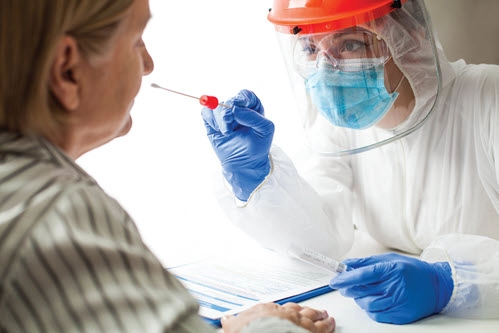Stay up to date with frequently changing testing guidance.
After a slow-to-start national testing strategy hampered by lack of supplies, lack of organization, and a sense of general disbelief about the veracity of SARS-CoV-2, the virus that causes COVID-19 infection, the Centers for Medicare & Medicaid Services (CMS) and the current presidential administration are doubling down on ways to enforce protections for residents in nursing homes.
The latest development in the strategy is a laserlike focus on testing residents and staff. Although MDS Alert has covered testing recommendations and requirements in past issues, the updates in guidance beg for more coverage. One major point: CMS has added another COVID-19-related Ftag (F886, COVID-19 Testing) to the Infection Control regulatory group, the third since the pandemic began, says Linda Elizaitis, RN, RAC-CT, BS, president and founder of CMS Compliance Group in Melville, New York.
Follow Testing Parameters
Most skilled nursing facilities do not have laboratories on-site, but the Department of Health and Human Services (HHS) has sent COVID-19 testing devices to more than 3,000 facilities across the country.
Recipients of these platforms can meet the testing requirement by using the devices but should note that there are other conditions attached. “Facilities can meet the testing requirements by using rapid point-of-care (POC) tests or by making arrangements with an off-site laboratory. Facilities that wish to conduct their own tests must have a CLIA Certificate of Waiver. If a facility cannot conduct COVID-19 POC testing, it should make arrangements with a lab to conduct the tests as per the requirement,” Elizaitis says.

Figuring out who needs to be tested — and when — sounds a little tricky at first. The who is pretty all-encompassing: Besides residents, facilities should be testing all facility staff, including “employees, consultants, contractors, volunteers and caregivers who provide care and services to residents on behalf of the facility, as well as students from affiliated academic institutions and student in the facility’s nurse aide training programs,” Elizaitis says.
The guidance for frequency of routine testing varies depending on local community transmission, and is either weekly, twice weekly, or monthly, per Department of Health and Human Services (HHS) recommendations.
The guidance on testing for individuals with symptoms remains consistent: Test anyone who appears symptomatic. Although asymptomatic infection and transmission is increasingly widely documented, the Centers for Disease Control and Prevention’s (CDC) current guidance is to test asymptomatic individuals only if there are other positive cases identified, such as in an outbreak situation, once your facility has conducted baseline testing.
“Routine testing of asymptomatic residents is not recommended unless prompted by a change in circumstances, such as the identification of a confirmed COVID-19 case in the facility. Facilities may consider testing asymptomatic residents who leave the facility frequently, such as for dialysis or chemotherapy,” says David R. Wright, director of safety & oversight group at CMS, in a late-August QSO memorandum.

Important: If a situation arises where a resident tests positive for COVID-19 upon being admitted to the facility, it does not constitute an outbreak, per the interpretative guidance, Elizaitis notes.
Note Additional Guidance on Refusal of Testing
Both residents and staff have the right to refuse COVID-19 testing, but facilities have different options depending on circumstances. Regardless, each organization and facility need to have procedures in place to address both potential situations. If a symptomatic staff member refuses, the facility is allowed to prohibit them from entering the building until they meet the “return to work” criteria around the virus. If the facility is conducting testing for an outbreak, the staff member shouldn’t be allowed in the building until the outbreak testing process is finished.
Guidance for testing of asymptomatic people has undergone various adjustments, but COVID-19 researchers and public health officials agree that asymptomatic people can contract and spread the virus. Look especially to your local health department policies and occupational health recommendations for residents, especially if they refuse testing. If you’re dealing with a resident or a resident representative who is refusing testing, staff should enter a conversation about the importance of testing. For symptomatic residents who refused testing, simply follow transmission-based precautions until the symptoms abate or the resident otherwise meets the criteria to be removed from such precautions.
Do this: Make sure you have procedures and policies in place that cover every scenario so you can respond quickly with the appropriate next steps.
